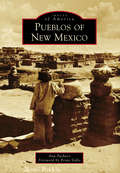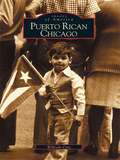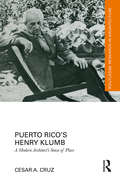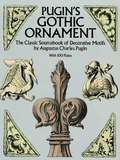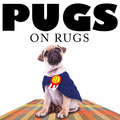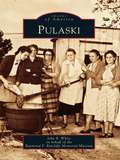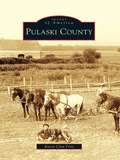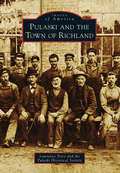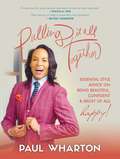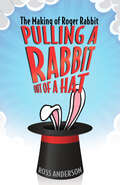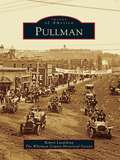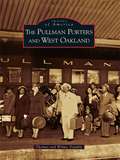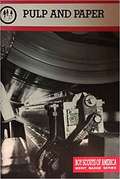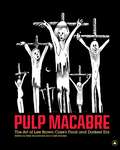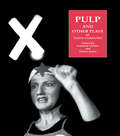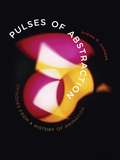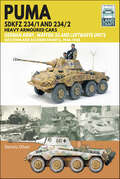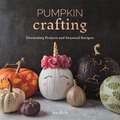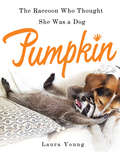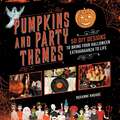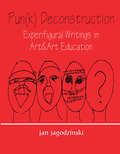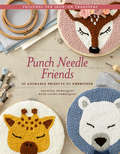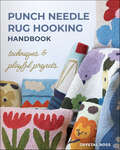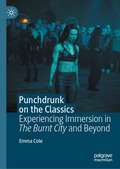- Table View
- List View
Pueblos of New Mexico (Images of America)
by Ana Pacheco Brian ValloAs early as 1851, photographers journeyed along the arduous Santa Fe Trail on horseback and in covered wagons on a quest to capture the magnificent vistas on film. In the ever-changing light of New Mexico's landscape, they photographed the faces of the Pueblo People and helped to document their ancient, unimaginable world. They became witness to millennia of history. New Mexico's first inhabitants are believed to have descended from the Anasazi, the largely nomadic group that settled along the Colorado Plateau around 200 AD. Most likely, drought conditions brought the population centers of the Anasazi villages located in the Four Corners of Colorado, Utah, Arizona, and New Mexico to settle along the Rio Grande Valley of New Mexico and the Mogollon Rim of Arizona in 1300 AD.
Puerto Rican Chicago (Images of America)
by Wilfredo CruzPuerto Ricans have a long history in Chicago. Beginning in the 1920s, a handful of middle-class Puerto Rican families sent their daughters and sons to study at prestigious universities in the city. While most returned to Puerto Rico, migration to Chicago peaked during the 1950s and 1960s. Enticed by the prospect of a better life for their families and future generations, thousands of Puerto Ricans came to Chicago in search of a brighter tomorrow. They came to Chicago as American citizens, yet still faced rampant discrimination and prejudice. In 1950, there were only 255 Puerto Ricans in Chicago; today, there are over 113,000. Chicago is home to a thriving Puerto Rican community, and its members continue to make important contributions to the political, educational, social, and cultural institutions of Chicago.
Puerto Rico’s Henry Klumb: A Modern Architect’s Sense of Place (Routledge Research in Architecture)
by Cesar A. CruzThis book follows Henry Klumb’s life in architecture from Cologne, Germany to Puerto Rico. Arriving on the island, Klumb was a one-time German immigrant, a moderately successful designer, and previously a senior draftsman with Frank Lloyd Wright. Over the next forty years Klumb would emerge as Puerto Rico’s most prolific, locally well-known, and celebrated modern architect. In addition to becoming a leading figure in Latin American modern architecture, Klumb also became one of Frank Lloyd Wright’s most accomplished protégés, and an architect with a highly attuned social and environmental consciousness. Cruz explores his life, works, and legacy through the lens of a sense of place, defined as the beliefs that people adopt, actions undertaken, and feelings developed towards specific locations and spaces. He argues that the architect’s sense of place was a defining quality of his life and work, most evident in the houses he designed and built in Puerto Rico. Puerto Rico’s Henry Klumb offers a historical narrative, culminating in a series of architectural analyses focusing on four key design strategies employed in Klumb’s work: vernacular architecture, the grid and the landscape, dense urban spaces, and open air rooms. This book is aimed at researchers, academics, and postgraduate students interested in Latin American architecture, modernism, and architectural history.
Pugin's Gothic Ornament: The Classic Sourcebook of Decorative Motifs with 100 Plates (Dover Pictorial Archive)
by Augustus C. PuginThis classic sourcebook of decorative motifs contains 100 plates of royalty-free Gothic designs, meticulously reproduced from rare 19th-century engravings. Many are floral and foliate designs rendered from panels, capitals, borders, brackets, friezes, grotesques, and other decorative elements from such architectural landmarks as New College Chapel at Oxford and Rouen Cathedral.
Pugs on Rugs
by Jack RussellWhat is it that makes pugs so lovable? Is it their doleful eyes? Their down-turned mouths? Furrowed brows? While they may look sad, they’ve certainly found their place in our homes and our hearts. Now the adorable creatures have a new home, sitting on rugs in 43 amusing photographs! What could be cuter?Pugs on Rugs celebrates different pugs on different rugs. The dog might be walking, sitting, or sleeping and the rug could be Persian, Aztec, or oriental, but the image is guaranteed to be cute and funny!People have been obsessed with pugs for centuries and each of this small book’s spreads features a photograph (or montage) alongside an amusing caption and a fascinating fact about the history and characteristics of this unique breed.Did you know that the first pugs were brought from China to Europe to serve as guard dogs? Or that a famous pug named Pompey once saved a Dutch prince from assassination? Have you heard about the eighteenth-century German secret society dedicated to the pug in which new members initiated themselves by wearing a collar, scratching at the door, and kissing the rear end of a giant porcelain pug? Yes indeed, pug lovers are an interesting breed and this volume is sure to get them laughing with delight.From bullish to pitiful, Pugs on Rugs is a fantastically fun book featuring some of the snuggliest pugs you’ve ever seen.
Pulaski
by Raymond F. Ratcliffe Memorial Museum John B. WhiteIn 1854, the agrarian area known as Pulaski was bisected by the Virginia and Tennessee Railroad, which brought with it access to new markets, reduced isolation created by the New River, and heavy industry. The 1870s saw the restoration of an economy decimated by war and the incorporation of Dublin and Newbern. The Pulaski Agricultural and Mechanical Association, incorporated in 1872 to promote "enterprise, industry, and thrift among the citizens," was forced to raise funds from the very Philadelphia capitalists who had laid claim to county mineral lands. By 1886, Pulaski City, a classic boomtown, became a microcosm of industrialization in the Central Appalachians. The change created a struggle between the land's agrarian past and industrialized future. Images of America: Pulaski provides glimpses into the rich history of this land. This collection of nearly 200 photographs helps tell the story of those owners of land and industry, those who labored for self-sufficiency, and those who sought to give their children a better life.
Pulaski County (Images of America)
by Karen Clem FritzFor centuries the shimmering waters of the historic Tippecanoe River have quietly marked the history of rural Pulaski County as the stream winds through the heart of the county's landscape, its banks lined with lush woods and rich farmlands. The river was the lifeblood of the Potawatomi Indians who fished its waters and canoed home to camps along the shores. They were followed by pioneer hunters and trappers lured by plentiful wildlife. Early settlers harnessed the river's energy to run saw- and gristmills. Later the Tippecanoe attracted weekend and summer visitors from the city looking for some quiet fishing and peaceful reflection. Pulaski County was established in 1839. Dotted with quaint towns, family farms, and locally owned businesses and light industry, the county has been shaped by a heritage of hard work, simple pleasures, neighborliness, and a determined self-sufficiency that comes of relative isolation. It is a rich and increasingly rare bucolic prospect--nourished by a vigilant river.
Pulaski and the Town of Richland
by Lawrence Petry Pulaski Historical SocietyIn 1801, the first settlers to the Pulaski and Richland area arrived on the eastern shores of Lake Ontario. These communities were shaped by notable personalities, including early residents Nathan Tuttle, Benjamin Winch, and the Mathewson family; tavern owner Pliny Jones; store owner Capt. John Meacham; businessman Charles Tollner; banker Robert Ingersoll; and philanthropist John Ben Snow. They built businesses and industries, shops and homes, and schools and churches that impacted and defined the town. Relying on the area's natural resources, the Salmon River was harnessed to power mills and later lured thousands of fishermen to its waters. The Selkirk Lighthouse became a prominent landmark at the mouth of that river.
Pulling It All Together: Essential Style Advice on Being Beautiful, Confident & (Most of All) Happy!
by Paul WhartonEveryone looks in the mirror and sees imperfections, even models and celebrities. But you don’t need to spend money on expensive skin treatments and spa visits. In Pulling It All Together, Paul Wharton shares the secrets of styling teams and the tricks photographers use to turn everyday women into supermodels. Wharton offers shopping, grooming, and lifestyle tips that will have you feeling drop-dead gorgeous and ready to take on the extraordinary adventures and all the good things life has in store. In the book you’ll find advice on: Fashion: dressing slimmer, how to accessorize, and, of course, shoes Skin care: exfoliation, masks, and more Makeup: foundation, mascara, and everything in between When you take the time to pull your look together, it frees up your mind to think more clearly and focus on what’s in front of you. An expert in front of and behind the camera, fashion and beauty consultant, lifestyle expert, and an entrepreneur with skin and hair care lines, Wharton is pivotally positioned to share keen insight and wisdom to make the world more beautiful one person at a time.
Pulling a Rabbit Out of a Hat: The Making of Roger Rabbit
by Ross AndersonWho Framed Roger Rabbit emerged at a nexus of people, technology, and circumstances that is historically, culturally, and aesthetically momentous. By the 1980s, animation seemed a dying art. Not even the Walt Disney Company, which had already won over thirty Academy Awards, could stop what appeared to be the end of an animation era. To revitalize popular interest in animation, Disney needed to reach outside its own studio and create the distinctive film that helped usher in a Disney Renaissance. That film, Who Framed Roger Rabbit, though expensive and controversial, debuted in theaters to huge success at the box office in 1988. Unique in its conceit of cartoons living in the real world, Who Framed Roger Rabbit magically blended live action and animation, carrying with it a humor that still resonates with audiences. Upon the film’s release, Disney’s marketing program led the audience to believe that Who Framed Roger Rabbit was made solely by director Bob Zemeckis, director of animation Dick Williams, and the visual effects company Industrial Light & Magic, though many Disney animators contributed to the project. Author Ross Anderson interviewed over 140 artists to tell the story of how they created something truly magical. Anderson describes the ways in which the Roger Rabbit characters have been used in film shorts, commercials, and merchandising, and how they have remained a cultural touchstone today.
Pullman
by The Whitman County Historical Society Robert LuedekingLocated at the confluence of three creeks, amid the rich agricultural soil of Eastern Washington's Palouse region, Pullman seemed destined to flourish. From its founding in the 1880s, growth was spurred by the discovery of artesian wells, its selection as the location of the State Agricultural College, and the building of rail lines through the town. Pullman, named for railroad car manufacturer George Pullman, became a thriving center of commerce, agriculture, and education. Today Pullman remains a vibrant commercial agricultural center, built upon wheat, peas, and lentils, with a downtown nestled among four hills. Pullman is home to cutting edge technology companies and a major research institution, Washington State University. Its rich heritage in agriculture, education, and technology guarantees its future as a highly successful 21st century city.
Pullman Porters and West Oakland, The
by Thomas Tramble Wilma TrambleA hub of transportation and industry since the mid-19th century, West Oakland is today a vital commercial conduit and an inimitably distinct and diverse community within the Greater Oaklandmetropolitan area. The catalyst that transformed this neighborhood from a transcontinental rail terminal into a true settlement was the arrival of the railroad porters, employed by the Pullman Palace Car Company as early as 1867. After years of struggling in labor battles and negotiations, the Brotherhood of Sleeping Car Porters Union became the first African American-led union to sign a contract with a large American company. The union's West Coast headquarters were established at Fifth and Wood Streets in West Oakland. Soon families,benevolent societies, and churches followed, and a true community came into being.
Pulp And Paper (Merit Badge Series)
by Boy Scouts of America StaffOutlines requirements for pursing a merit badge in pulp and paper, including instruction in the history of paper making, how fibers are derived from wood, how paper is made, and careers in the pulp and paper industry.
Pulp Macabre: The Art of Lee Brown Coye's Final and Darkest Era
by Mike Hunchback Caleb BraatenNo other artist working in mid-century pulp fiction created work as twisted as Lee Brown Coye. By the 1970s, after surviving a life-threatening illness, Coye would outdo himself, creating lurid illustrations exclusive to rare privately published books and fanzines. <P><P>With nearly one hundred gloriously rendered Coye-penned images, Pulp Macabre showcases Coye's final and darkest era, containing some of the most passionately ghoulish artwork ever made.Mike Hunchback is an enthusiast of various eras of extreme and bizarre underground art, and is currently working on a biography of original Fangoria magazine editor Robert "Uncle Bob" Martin.Caleb Braaten operates Sacred Bones Records, which has recently teamed with David Lynch to release his new album The Big Dream.
Pulp and Other Plays by Tasha Fairbanks
by Elaine Aston Gabriele GriffinFirst Published in 2004. Routledge is an imprint of Taylor & Francis, an informa company.
Pulse Protectors: ePattern from Vampire Knits (Potter Craft ePatterns)
by Kathy PendryKnitting instructions.
Pulses of Abstraction: Episodes from a History of Animation
by Andrew R. JohnstonReshapes the history of abstract animation and its importance to computer imagery and cinema Animation and technology are always changing with one another. From hand-drawn flipbooks to stop-motion and computer-generated imagery (CGI), animation&’s identity is in flux. But many of these moving image technologies, like CGI, emerged from the world of animation. Indeed, animation has made essential contributions to not only computer imagery but also cinema, helping shape them into the fields and media forms we know today. In Pulses of Abstraction, Andrew R. Johnston presents both a revealing history of abstract animation and an investigation into the relationship between animation and cinema. Examining a rich array of techniques—including etching directly onto the filmstrip, immersive colored-light spectacles, rapid montage sequences, and digital programming—Pulses of Abstraction uncovers important epistemological shifts around film and related media. Just as animation&’s images pulse in projection, so too does its history of indexing technological and epistemic changes through experiments with form, material, and aesthetics. Focusing on a period of rapid media change from the 1950s to the 1970s, this book combines close readings of experimental animations with in-depth technological studies, revealing how animation helped image culture come to terms with the rise of information technologies.
Puma Sdkfz 234/1 and Sdkfz 234/2 Heavy Armoured Cars: German Army and Waffen-SS, Western and Eastern Fronts, 1944–1945 (LandCraft)
by Dennis Oliver"....a well-researched title that covers a lesser known type and that manages to squeeze a heck of a lot into 64 pages." —WarWheels The lightning advances of the German armored units during the Polish and French campaigns were spearheaded by fast-moving, armed reconnaissance vehicles. But these early designs suffered heavily due to their light weaponry and thin armor and a program was soon underway, led by the firm of Büssing-NAG, which culminated in the development of the Sdkfz 234 series of heavy eight-wheeled armored cars, the first of which entered service in late 1943. These vehicles proved to be rugged and reliable and were gradually up-armed to serve in the infantry support role and eventually as tank killers. This volume of the LandCraft series concludes the story of the Sdkfz 234 series, examining the versions that took part in the last battles of the war. Using archive photos and extensively researched color illustrations Dennis Oliver examines the Sdkfz 234/1 and Sdkfz 234/2 and the units that operated these often neglected, yet important, armored vehicles. A key section of his book displays available model kits and aftermarket products, complemented by a gallery of beautifully constructed and painted models in various scales. Technical details as well as modifications introduced during production and in the field are also examined, providing everything the modeler needs to recreate an accurate representation of these historic tanks.
Pumpkin Crafting
by Jen RichYour ultimate guide to carving, painting and decorating pumpkins for your home, complete with tips and recipes for getting the most out of your pumpkin all season long. From playful and whimsical pumpkins that will liven up Halloween, Day of the Dead or Thanksgiving parties to sophisticated and elegant designs that will bring autumnal charm to your home all season long, you'll find projects to suit every style and taste.Divided and organised into helpful sections, you'll find:· A guide to the tools, tips and techniques that will help you achieve the best results· Pumpkin carving projects, for transforming your pumpkins and seasonal gourds into show-stopping jack-o-lanterns· Pumpkin painting projects, for transforming your pumpkin with a lick of paint, no sharp objects required· Pumpkin dressing projects, for turning your pumpkin into an original creation with glue, tape and other odds and ends· And recipes, for using every part of the pumpkin to create delicious meals and tasty snacksEach project features easy-to-follow instructions, whilst beautiful photographs throughout will give you all the inspiration you need. And handy templates at the back of the book can be copied and used again and again for perfect results every time.
Pumpkin: The Raccoon Who Thought She Was a Dog
by Laura L. YoungAs a baby, Pumpkin the Raccoon was abandoned by her parents after falling out of a tree and breaking her leg. Taken in by a family with two rescue dogs, Toffee and Oreo, Pumpkin gained a new set of "parents" and a life of luxury in the Bahamas.Pumpkin: The Raccoon Who Thought She Was a Dog is a sweet, unique look at an adorable household pet, captured in gorgeous, never-before-seen photographs in luxurious settings. Pumpkin's message is that friendship and love can be found in the most unlikely of companions. With a lot of personality, and a little bit of mischief, Pumpkin will capture hearts all around the world.
Pumpkins and Party Themes: 50 DIY Designs to Bring Your Halloween Extravaganza to Life
by Roxanne RhoadsBring your Halloween party theme to life with these quick tips and tricks!Pumpkins and Party Themes features ten unique party themes with five do-it-yourself pumpkin designs for each theme. The pumpkin projects have a variety of decorating ideas that include carving, painting, and mixed media craftiness and easy-to-follow steps on each creation. Author Roxanne Rhoads also includes quick ideas on how to bring the theme to life through décor, costumes, and activities. These fun party themes range from gothic elegance to Edgar Allan Poe, under the sea, let's get literary, and more! With beautiful full-color images to illustrate the tools needed, steps to follow, and final products, this book makes for the perfect gift for Halloween enthusiasts and party hosts alike!
Pun: Experifigural Writings in Art&art Education (Studies in Curriculum Theory Series)
by jan jagodzinskiIn Postmodern Dilemmas: Outrageous Essays in Art&Art Education and Pun(k) Deconstruction: Experifigural Writings in Art&Art Education, jan jagodzinski presents a series of essays covering a timespan of approximately ten years. These essays chart the theory and practice of art&art education as it relates to issues of postmodernity and poststructuralism concerning representation, identity politics, consumerism, postmodern architecture, ecology, phallocentrism of the artistic canon, pluriculturalism, media and technology, and AIDS. As a former editor of The Journal of Social Theory in Art Education and a founding member for the Caucus on Social Theory in Art Education, the author attempts to deconstruct the current art education paradigm, which is largely based on modernist tenets, and to reorient art education practice to social issues as developed in both media education and cultural studies. Part of the intent in these two volumes is to undertake a sustained critique of the 1982 Art in the Mainstream (A.I.M.) statement, which continues to be considered as the core value for art education. The distinct intention of this critique is to put forward a new value base for art&art education in these postmodern times. Many of the essays raise the need to be attentive to sex/gender issues in art&art education and the need to read the artistic discourse "otherwise." There is a sustained critique of the art programs developed by the Getty Center for the Arts, whose arts curriculum presents the paradigm case of late modernist thinking. Some essays are written in a provocative form that tries to accommodate such content. This is particularly the case in Pun(k) Deconstruction, where architectural discourse is deconstructed, and which includes an "artistic performance" given by the author in 1987. This singular set of volumes combines scholarship in the areas of gender studies, aesthetics, art history, art education, poststructuralism, and cultural studies in a unique blend of theory and practice for rethinking the field of art education.
Punch Needle Friends
by Faustine Cathy DuwicquetDiscover the world of punch needle embroidery with this modern take on a rediscovered craftNew to the world of punch needle embroidery, or an expert crafter looking for a fresh challenge? Punch Needle Friends is the perfect guidebook for both beginners and expert level needle crafters and the ideal introduction to a fun and new embroidery lesson: learning how to create 20 different contemporary animal motifs.With easy step-by-step instructions, handy templates, and beautiful photography, Cathy and Faustine Duwicquet walk readers through everything they will need to know about punch needling. Not only will readers develop a brand new set of punch needle skills, they'll have an impressive (and adorable) new project to show for it.
Punch Needle Rug Hooking Handbook: Techniques & Playful Projects
by Crystal RossTransform your home with folk-inspired punch needle creations In this handbook, learn everything you need to know to punch needle rug hook, from beginner techniques to expert tips. Explore 15 cozy, folk-inspired masterpieces with designs that feature a tapestry of floral, animal, and patterned motifs. You’ll learn about the elements of design and inspiration for crafting your own unique punch needle creations. Adorn your living space with charming and plush floor rugs, wall hangings, cushions, pillows, textural bags, and more designed by Crystal Ross. With this guide, you’ll be ready to craft a lifetime of unforgettable textile gifts for loved ones. Learn everything you need to know to punch needle, from basic techniques to expert finishing methods to tips for designing your own pieces, essential for bringing every project to life Create 15 unique, folk-inspired punch needle projects that are high quality and beautiful in any home, including floor rugs, bags, pillows, a chair cushion, and more Enjoy a wide variety of project types that seamlessly blend functionality with beauty, perfect for enhancing your home decor, wardrobe, or delighting loved ones
Punchdrunk on the Classics: Experiencing Immersion in The Burnt City and Beyond
by Emma ColePunchdrunk on the Classics: Experiencing Immersion in The Burnt City and Beyond draws attention to Punchdrunk’s use of ancient Greek literature in their creation of immersive theatre. The book documents and analyses the effects of utilising Greek tragedy within both Punchdrunk’s creative development windows, and the company’s final staged productions. It features material stretching from The House of Oedipus (2000) right through to The Burnt City (2022-23), on which the author worked as dramaturg. Chapters include rehearsal studies, explorations of how Greek literature can shape an audience’s experience in immersive theatre, and considerations of how The Burnt City might change our understanding of the poetics of immersion in antiquity. Overall, Punchdrunk on the Classics provides an unparalleled depth of insight into an individual Punchdrunk production, and highlights the until-now overlooked significance of antiquity within Punchdrunk’s practice.
